MolecularOrbital Theory
第二节 分子轨道理论
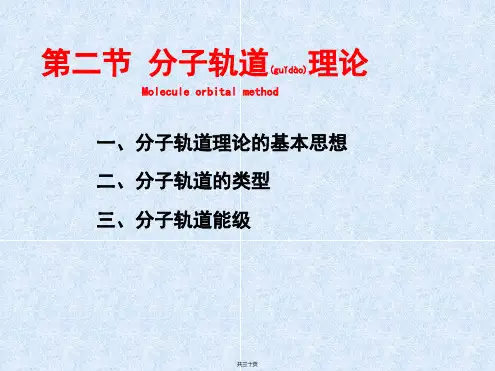
<
Hψ =[-
1 2
▽2
-
1 r1
-
1 r2
+
1 R
]ψ
=
Eψ
可见,当忽略了电子间的排斥势能后,H2 的波动方程就变成H2+ 的波
动方程。
这样,我们就可以把复杂的问题简单处理。这就是所谓单电子波函数
(轨道近似)的基本思想。
共三十页
2.原子轨道线性组合成分子(fēnzǐ)轨道
由前面的讨论我们知道,H2 的波动方程近似于 H2+ 的波动方程,这 样,在运用变分法处理波动方程时,就可以选用两个 H 原子的 1s 轨道 的组合作为试探函数。即:
共三十页
由此可知: 2h = [(αa-αb)2 + 4β2 ]1/2 - (αa-αb)
当(αa - αb)>> 2∣β∣时: (φa 和φb 轨道能量相差很大)
(αa-αb)2 + 4β2 ≈ (αa-αb)2
则: 2h ≈ [(αa-αb)2 ]1/2 - (αa-αb) ≈0
即: h≈0
于是: E1 ≈αb
主要有两种方法。即,分子轨道法和价键法。
1928 年,美国化学家密里肯(Mulliken RS)在海
特勒和伦敦用量子力学基本原理讨论氢分子结构的基础
上提出了分子轨道理论。
分子轨道理论的基本思想,主要体现在如下三个方 面。
R.S.Robert Sanderson Mulliken (896-1986)
-
+
σh 失效
记为:σ*
记为:σ
共三十页
2.π轨道
对称性特征:对键轴中心呈对称性或反对称性
例如:
++
分子轨道理论
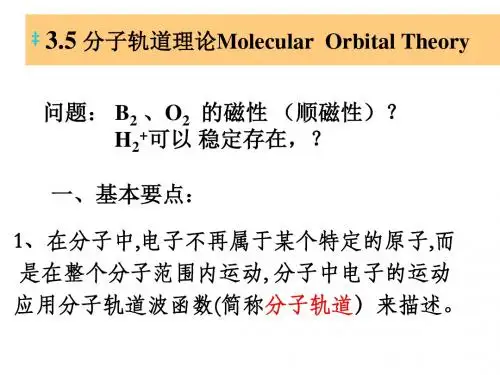
才能组成分子轨道
b、d、e符合 a、c不符合
② 能量近似原则 只有能量相近的原子轨道才能组合成有效 的分子轨道
H1S O2P Cl3P Na3S
-1312 (KJ/mol) -1314 (KJ/mol) -1251 (KJ/mol) -496 (KJ/mol)
可以 不行
③ 最大重叠原则
在对称性匹配的条件下,原子轨道的重叠程度越 大,组合成的分子轨道能量降低得越多,形成的 化学键越稳定。
4、分子轨道的几种类型
头碰头形成轨道 、* ,沿键轴(x轴) 方向呈圆柱形对称的重叠
肩并肩形成轨道 、 *,通过键轴的平面 (xz平面、xy平面)呈平面反对称的重叠
2 2
(
2
px
)
2
N2
14e
KK
(
2
s
)
2
(
2s
)
2
2 2
py pz
2 2
(
2
px
)
2
键级为3:二个 键,一个键
抗磁性
问题:N2 + 分子轨道电子排布式如何? 并比较N2 + 、N2其稳定性。
C2 的分子轨道
2Px*
键级为2
2Py* 2Pz*
2S*
2S
2S
2S
1S*
1S
1S
1S
KK
(
2s
)
2
(
2s
)
2
(
2
px
)
2
2 2
py pz
2 2
关于杂化轨道理论的一些浅显认识【毕业论文,绝对精品】
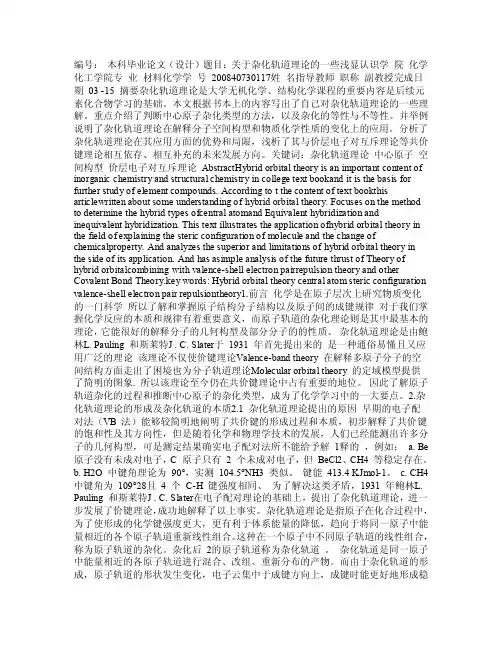
编号:本科毕业论文(设计)题目:关于杂化轨道理论的一些浅显认识学院化学化工学院专业材料化学学号200840730117姓名指导教师职称副教授完成日期03 -15 摘要杂化轨道理论是大学无机化学、结构化学课程的重要内容是后续元素化合物学习的基础。
本文根据书本上的内容写出了自己对杂化轨道理论的一些理解。
重点介绍了判断中心原子杂化类型的方法,以及杂化的等性与不等性。
并举例说明了杂化轨道理论在解释分子空间构型和物质化学性质的变化上的应用。
分析了杂化轨道理论在其应用方面的优势和局限,浅析了其与价层电子对互斥理论等共价键理论相互依存、相互补充的未来发展方向。
关键词:杂化轨道理论中心原子空间构型价层电子对互斥理论AbstractHybrid orbital theory is an important content of inorganic chemistry and structural chemistry in college text bookand it is the basis for further study of element compounds. According to t the content of text bookthis articlewritten about some understanding of hybrid orbital theory. Focuses on the method to determine the hybrid types ofcentral atomand Equivalent hybridization and inequivalent hybridization. This text illustrates the application ofhybrid orbital theory in the field of explaining the steric configuration of molecule and the change of chemicalproperty. And analyzes the superior and limitations of hybrid orbital theory in the side of its application. And has asimple analysis of the future thrust of Theory of hybrid orbitalcombining with valence-shell electron pairrepulsion theory and other Covalent Bond Theory.key words: Hybrid orbital theory central atom steric configuration valence-shell electron pair repulsiontheory1.前言化学是在原子层次上研究物质变化的一门科学所以了解和掌握原子结构分子结构以及原子间的成键规律对于我们掌握化学反应的本质和规律有着重要意义,而原子轨道的杂化理论则是其中最基本的理论,它能很好的解释分子的几何构型及部分分子的的性质。
《结构化学》教学大纲(英文版)
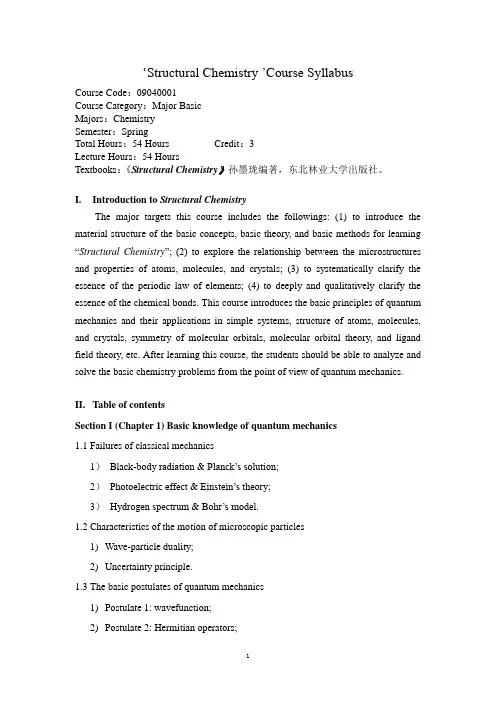
‘Structural Chemistry ’Course SyllabusCourse Code:09040001Course Category:Major BasicMajors:ChemistrySemester:SpringTotal Hours:54 Hours Credit:3Lecture Hours:54 HoursTextbooks:《Structural Chemistry》孙墨珑编著,东北林业大学出版社。
I.Introduction to Structural ChemistryThe major targets this course includes the followings: (1) to introduce the material structure of the basic concepts, basic theory, and basic methods for learning “Structural Chemistry”; (2) to explore the relationship between the microstructures and properties of atoms, molecules, and crystals; (3) to systematically clarify the essence of the periodic law of elements; (4) to deeply and qualitatively clarify the essence of the chemical bonds. This course introduces the basic principles of quantum mechanics and their applications in simple systems, structure of atoms, molecules, and crystals, symmetry of molecular orbitals, molecular orbital theory, and ligand field theory, etc. After learning this course, the students should be able to analyze and solve the basic chemistry problems from the point of view of quantum mechanics.II.Table of contentsSection I (Chapter 1) Basic knowledge of quantum mechanics1.1 Failures of classical mechanics1)Black-body radiation & Planck’s solution;2)Ph otoelectric effect & Einstein’s theory;3)Hydrogen spectrum & Bohr’s model.1.2Characteristics of the motion of microscopic particles1)Wave-particle duality;2)Uncertainty principle.1.3The basic postulates of quantum mechanics1)Postulate 1: wavefunction;2)Postulate 2: Hermitian operators;3)Postulate 3: Schrödinger equation;4)Postulate 4: linearity and superposition;5)Postulate 5: Pauli exclusion principle.1.4Applications of quantum mechanics in simple cases1)Free particle in one-dimensional (1D) box;2)Applications of the 1D-box model in simple chemical systems;3)Free particle in two-dimensional (2D) & three-dimensional (3D) box;4)Tunneling & scanning tunneling microscopy (STM).Section II (Chapter 2) Structures and properties of atoms2.1 One-electron atom: H atom1)The Schrödinger equation of H atoms;2)Solution of the Schrödinger equation of H atom.2.2Quantum numbers1)Principle quantum number, n;2)Angular momentum quantum number, l;3)Magnetic quantum number, m;4)Zeeman effect.2.3Wavefunction and electron cloud1)Radial distribution;2)Angular distribution;3)Spatial distribution.2.4 Structure of multi-electron atoms1)The Schrödinger equation of multi-electron atoms•Self-consistent field method;•Central field approximation.2)The building-up principles and electron configuration of multi-electron atoms•Pauli exclusion principle;•Principle of minimum energy;Hund’s rule.2.5Electron spin and Pauli exclusion principle2.6Atomic spectroscopy1)Orbital-spin coupling;2)Spectroscopic terms & term symbol;3)Derivation of atomic term.4)Hund’s rule on the spectroscopic terms;2.7Atomic properties1)Energy of ionization;2)Electron affinity;3)Electronegativity.Section III (Chapters 3-6) Structures and properties of molecules Chapter 3 Geometric structure of molecules─Molecular symmetry & symmetry point group3.1Symmetry elements and symmetry operations1)Symmetry elements and symmetry operations;2)Combination rules of symmetry elements;3.2Point groups & symmetry classification of molecules3.3Point groups & groups multiplication3.4Applications of molecular symmetry1)Chirality & optical activity;2)Polarity & dipole moment.Chapter 4 S tructure of biatomic molecules (X2 & XY)4.1 Linear variation method and structure of H2+ ion1) Shrödinger equation of H2+ ion;2) Linear variation method;3) Treatment of H2+ ion using linear variation method;4) Solutions of H2+ ion.4.2 Molecular orbital theory and diatomic molecules1) Molecular orbital theory;2) Structure of homonuclear diatomic molecules (X2);3) Structure of heteronuclear diatomic molecules (XY).4.3 Valence bond (VB) theory and H2 moleculeChapter 5 Structure of polyatomic molecules (A)5.1 Structure of Methane (CH4)1) Delocalized molecular orbitals of methane (CH4);2) Localized molecular orbitals of methane (CH4).5.2 Molecular orbital hybridization1) Theory of molecular orbital hybridization;2) Construction of hybrid orbitals;3) Structure of AB n molecules;4) Molecular stereochemistry: valence shell electron-pair repulsion (VSEPR)model.5.3 Delocalized molecular orbital theory─Hückel molecular orbital (HMO) theory1) HMO method & conjugated systems;2) HMO treatment for butadiene;3) HMO treatment for cyclic conjugated polyene (C n H n);4) Molecular diagrams;5) Delocalized π bonds.5.4 Structure of electron deficient molecules5.5 Symmetry of molecular orbitals and symmetry rules for molecular reactions5.6 Molecular spectroscopy1)Infrared absorption spectroscopy: molecular vibrations;2)Raman scattering spectroscopy: molecular vibrations;3)Fluorescence spectroscopy: electronic transitions;4)NMR spectroscopy: nuclear magnetic resonances.Chapter 6 Structure of polyatomic molecules (B), coordination compounds 6.1 Crystal field theory6.2 CO and N2 coordination complexes6.3 Organic metal complexes1) Zeise’s salts;2) Sandwich complexes.6.4 Clusters1) Transition-metal cluster compounds2) Carbon clusters and nanotubesSection IV (Chapters 7-9) Structure of crystalsChapter 7 Basics of crystallography7.1 Periodicity and lattices of crystal structure1) Characteristics of crystal structure;2) Lattices and unit cells;3) Bravais lattices and unit cells of crystals;4) Real crystals & crystal defects.7.2 Symmetry in crystal structure1) Symmetry elements and symmetry operations;2) Point groups (32) and space groups (230).7.3 X-Ray diffraction of crystals1) X-ray diffraction of crystals•Laue equation;•Bragg’s law;•Reciprocal lattice.2) Instrumentation of X-ray diffraction;3) Applications of X-Ray diffraction•Single crystal diffraction: crystal structure determination;•Powder diffraction: qualitative & quantitative analysis of crystalline materialsChapter 8 Crystalline solids, I: metals and alloys8.1 Close Packing of Spheres1) Close packing of identical spheres;2) Packing density;3) Interstices.8.2 Structures and Properties of Pure Metals8.3 Structures and Properties of AlloyChapter 9 Crystalline solids, II: ionic crystals9.1 Packing of Ions;9.2 Crystal Structure of Some Typical Ionic Compounds9.3 Trend of Variation of Ionic Radii9.4 Pauling Rule of Ionic Crystal Structure9.5 Crystals of Functional Materials1) Nonlinear optical materials;2) Magnetic materials;3) Conductive polymers;4) Semiconductors: band gap and photocatalysisIII.Table of ScheduleReferences[1] 王荣顺主编,东北师范大学等,《结构化学》,高等教育出版社,2003年。
共价键理论

共价键理论
一个原子含有几个未成对电子,就可以和几个自旋量 子数不同的电子配对成键,或者说,原子能形成共价键的数 目是受原子中未成对电子数目限制的,这就是共价键的饱和 性。例如,H原子只有一个未成对电子,它只能形成H2而不 能形成H3;N原子有三个未成对电子,N和H只能形成NH3, 而不能形成NH4。由此可知,一些元素的原子(如N、O、F 等)的共价键数等于其原子的未成对电子数。
共价键理论
图2-7 CH4分子的形成
共价键理论
C原子的1个s轨道与3个p轨道经杂化形成4个sp3杂化轨道 ,每一个sp3新轨道一端膨胀一端缩小,C原子和H原子成键时 从较大的一端进行轨道重叠,4个sp3杂化轨道间的夹角为 109.5°。可见,原子轨道杂化的原因是杂化后轨道形状发生改 变(一端显得突出而肥大),便于最大重叠;轨道方向改变,使 成键电子距离最远,斥力最小,能量降低。总之,杂化后能 增大轨道重叠区域,增强成键能力,使分子更稳定。
共价键理论
(2)π键。 原子轨道以“肩并肩”的方式 发生重叠,轨道重叠部分对通过
一个键轴的平面具有能面反对称性,这 种键称为π键,如pzpz、pypy轨道重叠形成π 键,如图2-5(b)所示。
共价键理论
图2-5 σ键和π键形成示意图
共价键理论
有些分子中既有σ键, 也有π键。例如,N2分子的 结构中有一个σ键和两个π键。 N原子的电子层结 ,而pypy、pz-pz分别沿y轴和z轴 相互平行或以“肩并肩”的 方式重叠形成π键,如图2-6 所示。
含有配位键的化合物称为配位化合物,这类化合物将在以后 的章节中讨论。
第四章 休克尔(Hückel) 分子轨道理论
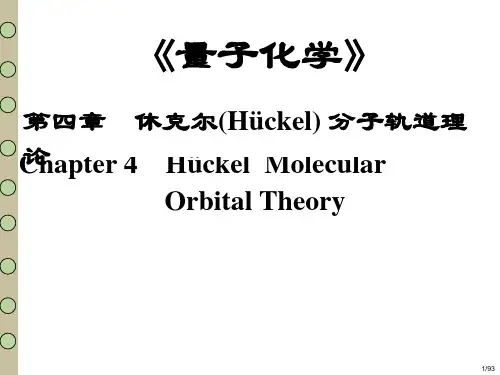
第四章
<0
相邻C间交换积分为
相间C间交换积分为0
各C原子参与共轭前2p轨道能量均为, 相邻的2p轨道间交盖引起的能量下降值为, 相邻的2p轨道间的重叠近似为0。 对共轭分子体系,在σ-π分离和π电子近似下, 应用线性变分法,能量对变分系数求一阶导数,则 可得 n 个线性方程(久期方程)。
第四章
0
目录 18/93
量子化学
属于E值对应的一套系数c1 , c2 ,…, c k, 波函数Ψ
第四章
c11 c 2 2 c k k c i i
i 1
k
归一化条件:
E有k个根E0, E1,…,Ek-1, E0为基态,其它为激发态。 所有分子轨道理论都基于变分方法而进行。
2/93
量子化学 4.1 变分法
第四章
设体系哈密顿算符 的本征值按大小次序排列为: E0≤E1≤E2≤…Ei≤… 等号表示有简并态情形。 设属于每个本征值的本征函数分别为: 0 , 1 , 2 , …,i ,… 则存在 的系列本征方程:
3/93
量子化学
第四章
根据厄米算符本征函数的性质, i , i 0 , 1, 2
i 1, 2 , , k
其中:
H ij i H j d
* S ij i j d
18
*
上式中E 代替了 ,因为求解上述方程可以得到E的 一组解,其中最小的一个就是体系基态能量的近似值。
16/93
量子化学
为0,称此行列式为久期行列式。
第四章
ci 不全为零的条件是它们的系数构成的行列式
此,一个不太理想的 可能给出了较好的E0近似
价键理论和分子轨道理论
1. 基本要点
● 成键时能级相近的价电子轨道相混杂,形成新的 价电子轨道——杂化轨道
● 杂化前后轨道数目不变 ● 杂化后轨道伸展方向,形状和能量发生改变
变了 总之,杂化后的轨道
●轨道成分变了
●轨道的能量变了
结果当然是更有利于成键!
●轨道的形状变了
● 在 BCl3 和 NCl3 分子中,中心原子的氧化数和配体 数都相同,为什么两者的空间分子结构却不同?
● 在 sp2 和 sp 杂化轨道中,是否也存在不等性杂化? 各举一例! 例如 SO2 和 CO
s-p-d 杂化轨道
s-p-d hybrid orbital
sp3d
sp3d2
假设
理论
Pauling
曲线的最低点相应于吸引力等于 排斥力的状态, 该状态下两核间的平 衡距离 R0 叫做核间距(符号为 d ),与 核间距 d 对应的势能(Ed)则是由气态 正、负离子形成离子键过程中放出的 能量。
H2分子的形成
显然,图形反映了两个中性原子间通过共用电子对相 连形成分子,是基于电子定域于两原子之间,形成了一 个密度相对大的电子云(负电性),这就是价键理论的 基础。因此,共价键的形成条件为:
中心原子价电子数>8
S : (Ne) 3s2 3p4 3d0
Cl
Number of valence electrons = 6 + (4 x 7) = 34
Cl
Cl P
Cl Cl
FF S
P : (Ne) 3s2 3p3 3d0
Number of valence electrons = 5 + (5 x 7) = 40
分子轨道理论
s,px 沿y轴重迭,β= 0, LCAO无效,对称性不允许. s,px沿x轴重迭, Sab>0,|β| 增大,对称性允许.
Sab>0, 对称性匹配, 是MO形成的首要条件,决定能否成键。
其它两条件解决效率问题。
只有对称性相同的AO才能组成MO。
S ab a* bd
对称性允许 +
+ + 相长
Eb
a Ea
A
U
1
E1
AB
B
两个AO形成两个MO时,AO能级差越小,形 成的MO能级分裂越大,电子转移到低能量的成键 MO后越有利。 反之,AO能级差越大,形成的MO 能级分裂越小,电子转移到低能量的成键MO后能 量下降越不明显.
在低能量的成键MO中, 低能量的AO组份较多; 在高能量的反键MO中, 高能量的AO组份较多。
轨道重叠与共价键的方 向性有密切关系. 例如, 环丙 烷中C采取sp3杂化,应以 109.5o重叠成键, 而键角只有 60o . 所以, 杂化轨道在核连 线之外重叠成弯键. 重叠不能 达到最大, 成键效率不高.
弯键模型
以往的解释是: 沿核连线成键 时, 为适应键角所要求的60o , sp3 杂化键被迫弯曲而产生“张力”.
分子轨道理论
分子轨道理论(MO理论) 1932年美国科学家莫立根(Mulliken)洪特(Humd)等人先后 提出了分子轨道理论 (Molecular Orbital Theory)
一. 理论要点: 1、分子轨道理论的基本观点是把分子看作一个整体,其中电子
不再从属于某一个原子而是在整个分子的势场范围内运动。 分子中每个电子的运动状态也可用相应的波函数来描述。 2、分子轨道是由分子中原子的原子轨道线性组合而成,简称 LCAO。组合形成的分子轨道数目与组合前的原子轨道数目 相等。 3、原子轨道线性组合成分子轨道后,每一个分子轨道都有一相 应的能量,分子轨道中能量高于原来的原子轨道者称为反键 轨道,能量低于原来的原子轨道者称为成键轨道。 4、分子轨道中的电子的排布原则:保里不相容、能量最低、洪 特规则。 5、根据分子轨道的对称性不同,可分为σ键和π键。
分子轨道理论
分子轨道理论价键理论、杂化轨道理论虽能较好地说明共价键形成的本质和分子的空间构型,但由于其都是以电子配对为基础的,只考虑形成共价键的电子,而未将分子看成是一个整体,因此在应用中有其局限性。
按照价键理论,O 2分子的路易斯电子式是..O O ......,分子中应该没有成单电子,但是测定其磁性,表明氧为顺磁性物质,液态氧和固态氧极易为磁铁所吸引,故O 2分子中应该有成单电子。
高温下的B 2分子虽具有偶数的价电子,但它也是顺磁性物质。
而H 2+、O 2+、NO 、NO 2等奇数电子分子或离子也能够稳定存在。
这些事实,价键理论无法加以解释。
1932年,美国密立根和洪特等人提出了分子轨道理论(molecular orbital theory ,简称MO 法)。
该理论以量子力学为基础,把原子电子层结构的主要概念,推广到分子体系中去,很好地说明了上述实验事实,从另一个方面揭示了共价分子形成的本质。
1.分子轨道理论的基本要点 ⑴ 分子轨道理论认为,分子中的电子不再从属于某个特定的原子而是在整个分子空间范围内运动。
因此,分子中的电子运动状态应该用相应的波函数ψ(简称分子轨道)来描述。
每个分子轨道也具有相应的能量E ,由此可得到分子轨道能级图。
⑵ 分子轨道是由分子中原子的原子轨道线性组合(1inear combination of atomic orbitals )而成的。
n 个原子轨道线性组合,可以形成n 个分子轨道。
其中,2n个分子轨道的能量高于原子轨道,称为反键分子轨道(antibonding orbital ),2n 个分子轨道的能量低于原子轨道,称为成键分子轨道(bonding orbital )。
⑶ 原子轨道要有效组合成为分子轨道,必须遵循三个原则,即能量近似原则、轨道最大重叠原则和对称性匹配原则。
⑷ 分子中的电子将遵循保里不相容原理、能量最低原理和洪特规则,依次填入分子轨道之中。
2.原子轨道线性组合形成分子轨道原子轨道有效组合形成分子轨道必须遵循三个原则:能量近似原则、轨道最大重叠原则和对称性匹配原则。
分子轨道理论的发展及其应用
分子轨道理论的发展及其应用姓名:班级:学号:v分子轨道理论(Molecular Orbital ,简称MO )最初是由Mulliken 和Hund 提出,经过Huckel (简单分子轨道理论,简称HMO), Roothaan (自洽场分子轨道理论),福井谦一(前线分子轨道理论,简称FMO), Woodward和Hofmann (分子轨道对称守恒原理)等众多科学家的不断探索,形成了一套成熟的理论,与价键理论(VB)和配位场理论(LF)—通解决分子结构问题。
分子轨道理论经过半个世纪的迅猛发展,已经成为当代化学键理论的主流。
如今多用于共轭分子的性质的研究,量子化学的研究,分子的化学活性和分子间的相互作用的研究,基元化学反应的研究,指导某些复杂有机化合物的合成。
1 分子轨道理论分子轨道理论的基本观点是把分子看做一个整体,其中电子不再从属于某一个原子而是在整个分子的势场范围内运动。
分子中每个垫子是在原子核与其他电子组成的平均势场中运动,其运动状态可用单电子波函数表示,称为分子轨道[1]。
1.1 分子轨道理论的产生1926-1932年,在讨论分子(特别是双原子分子)光谱是,Mulliken⑵和HuncP] 分别对分子中的电子状态进行分类,得出选择分子中电子量子数的规律,提出了分子轨道理论。
他们还提出能级相关图和成键、反键轨道等重要概念。
1931-1933年,Huckel提出了一种简单分子轨道理论(HMO)⑷,用以讨论共轭分子的性质,相当成功,是分子轨道理论的重大进展。
1951年,Roothaan在Hartree-Fock方程[5]⑹的基础上,把分子轨道写成原子轨道的线性组合,得到Roothaan方程⑺。
1950年,Boys用Gauss函数研究原子轨道,解决了多中心积分的问题,从Hartree-Fock-Roothaan方程出发,应用Gauss 函数,是今天广为应用的自洽场分子轨道理论的基础,在量子化学的研究中占有重要地位。
